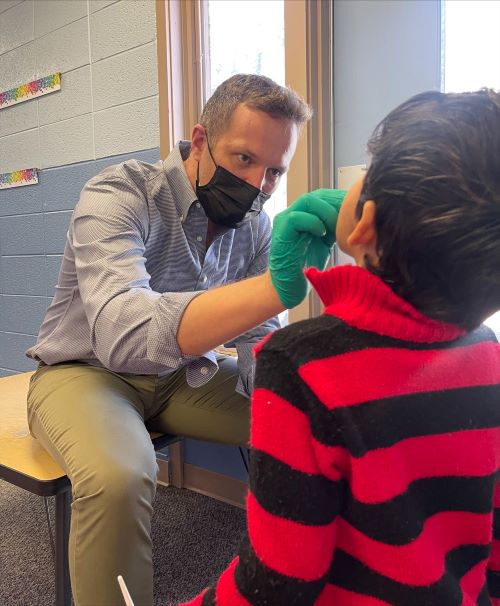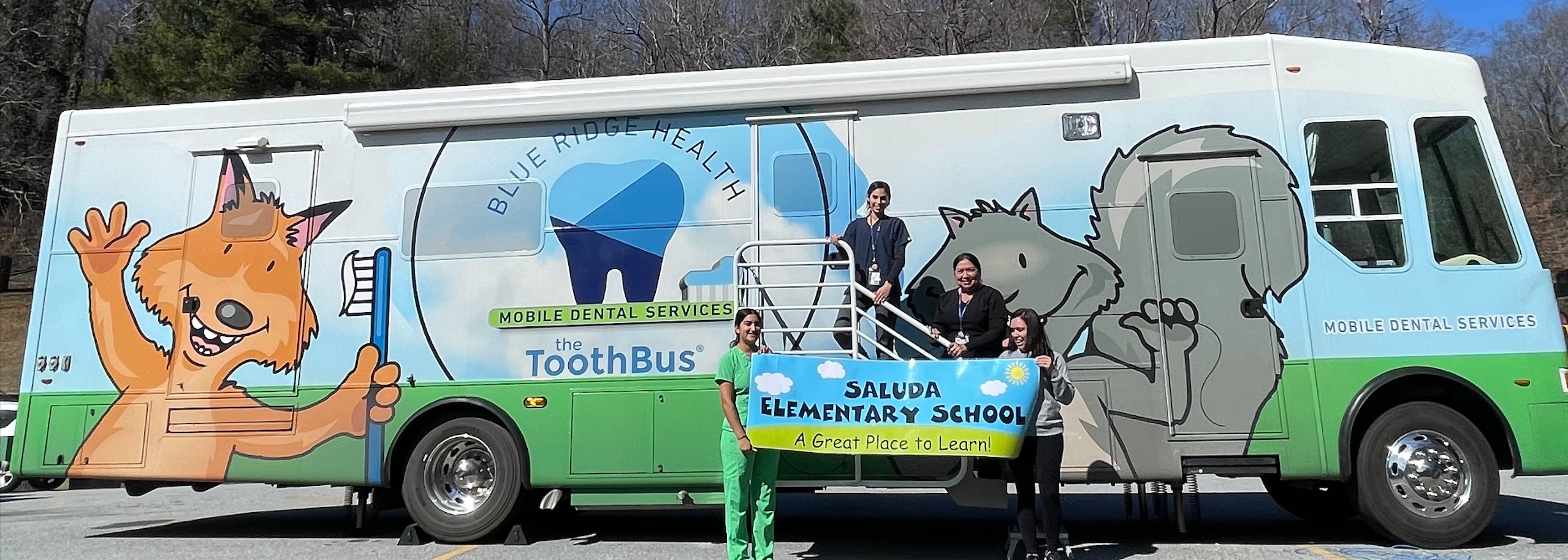In just one school year, Blue Ridge Health in North Carolina has helped more than 1,200 children get the dental care they need through teledentistry.
But that help comes with its challenges.
“Internet connectiv . . .” says Ben Cozart, DDS, the dental director at Blue Ridge Health, cutting out, on cue, as he was explaining the program during a phone call.

Blue Ridge Health dental hygienist takes pictures of child’s mouth in mobile dental services bus
“The cell phone service,” he continues, rejoining the call. “If you’re in between two mountains, sometimes the signal is not great. And of course, a lot of the schools that have the highest need are more remote, rural schools that are deeper in the mountains.”
Blue Ridge Health is a Federally Qualified Health Center (FQHC) in Brevard — a city surrounded by mountains —that mostly serves patients who are enrolled in Medicaid or uninsured. Digital interruptions can be a challenge, but the team doesn’t let them stand in the way of growing its school teledentistry program.
Cozart says the internet connection needs to be strong enough to run dental software and transfer information, like digital x-rays, and the FQHC has found a solution.
“We found out after trying different things that the best thing is just to use the school’s guest internet networks,” he says. “Luckily, we have a good IT team that contacts the school ahead of time to make sure that security and all those necessary things are taken care of ahead of time.”
Joining CareQuest Institute’s Community Oral Health Transformation (COrHT) Initiative has given the program a boost, too.
COrHT Support in North Carolina
Teledentistry was what intrigued Cozart the most about COrHT when he heard about the initiative. The FQHC first got its teledentistry program up and running in early 2022, when it was involved in an initiative with The Duke Endowment and Blue Cross Blue Shield of North Carolina Foundation. Later that year, it joined COrHT.
“The CareQuest Institute team has been great, and I think what I always enjoy the most from these things are the in-person conferences — gatherings — because it’s just a really rewarding feeling to be in the room with so many different people who are ultimately trying to do the same thing and help their communities,” Cozart says.
COrHT features a learning community for dental care teams. The initiative reimagines efficient, equitable oral health care and promotes the imminent shift toward value-based care (VBC) in dentistry. CareQuest Institute’s Three Domain Framework — which focuses on 1) teledentistry, 2) minimally invasive care (non-surgical treatment of disease), and 3) integration of oral health with overall health care — serves as the foundation for the learning.

Ben Cozart, DDS, applies fluoride varnish to child’s teeth
During the early work with COrHT, according to Stephanie Clester, clinical content and support specialist at CareQuest Institute, dental teams completed training in areas to help them implement and succeed in a variety of areas aligned with the transition to VBC, including teledentistry.
“By implementing this technology, dental providers now can reach more patients to reduce the burden of oral disease for those who need it most, making teledentistry a tool to achieve accessible and equitable oral health,” says Clester. “The COrHT Initiative is an opportunity for innovative dental professionals to lead the charge to transition toward VBC.”
The COrHT Initiative, a partnership between CareQuest Institute; the Blue Cross Blue Shield of North Carolina Foundation; and the North Carolina Oral Health Collaborative (NCOHC), a program of the Foundation for Health Leadership & Innovation (FHLI), launched last year in North Carolina.
Cozart knows the state — and his area — well. He grew up about half an hour from Blue Ridge Health.
“I first was aware of Blue Ridge Health when I was a rising fourth-year dental student at University of North Carolina. I did a rotation at Blue Ridge Health,” he says. “So, I saw patients there for a month, and that kind of opened my eyes to community health dentistry. I really didn’t know much about it. I didn’t know that it existed.”
He started working there straight out of dental school in 2014 and has been there ever since — working his way up from staff dentist to dental director.
“The department has grown a whole lot in different directions than when I first came on,” Cozart says. “It has been fun to see that and contribute to that growth.”
Providing Oral Health Care Through Teledentistry in Schools
Cozart says many times children miss out on dental appointments because their parents don’t want to take off work and take their children out of school, and the COVID-19 pandemic didn’t help.

Blue Ridge Health Mobile Dental Services travels to schools three days a week
“Like many things that got put on hold — school for example — a lot of patients of all different ages didn’t go to the dentist,” Cozart says. “And unfortunately, a lot of the kids that we see were included in that.”
Cozart says Blue Ridge Health owns two mobile units, or buses, that go to the elementary schools three days a week.
“You walk on the bus, and there are two dental laboratories that look like just a smaller version of a dental office,” he says. “It’s the hygienist and the assistant. The asynchronous teledental aspect is the dentist looking at the end of the day through all those exams, and then we have the team contact the parents to let them know what’s needed.”
A 2020 update to a North Carolina law gave dental hygienists the opportunity to get a public health endorsement on their license, which allows them to perform preventive procedures in nontraditional settings if they have written permission from a dentist, rather than a dentist examining the patient in person.
“They can go out without a dentist being on the bus or on the property and actually provide an assessment, which is bitewings and radiographs, prophy, fluoride, and intraoral images and sealants,” Cozart says.
It’s a win for all involved: The children get access to oral health care but also don’t miss too much time in the classroom. The parents don’t have to miss work. And the dentists can oversee care for more patients.
“It’s sort of allowed us to do two things at once,” Cozart says.

Dental hygienist cleans child’s mouth in Blue Ridge Health Mobile Dental Services bus
Cozart says he’s appreciative that the COrHT Initiative has helped provide Blue Ridge Health patients and providers in the community with the support they need, especially through teledentistry.
“We’re always trying to look at ways to evolve and grow our standard of care, and so the goal of COrHT and working with CareQuest Institute was really just to continue to develop quality-driven evidence-based dentistry,” he says.
Building relationships with other organizations has been important, too. Clester points to the peer-to-peer learning as one of the most valuable takeaways for participants.
“Cozart’s previous experience with teledentistry prior to the COrHT Initiative has made him a resource for others who only recently implemented teledentistry,” Clester says. “His support for his colleagues to answer questions and guide them demonstrates how a supportive community has a ripple effect to reach even farther.”
The COrHT Initiative in North Carolina wraps up in September. NCOHC and CareQuest Institute will later develop a comprehensive impact report to help participating safety net clinics sustain their work and influence long-term reform, something from which Cozart believes Blue Ridge Health will benefit.
“And of course,” he says, “we want to improve the overall quality of our dental care.”
Part of improving that care is looking ahead to evaluate what their next steps are after students leave the classrooms in the next month.
“We’re finishing out the end of the school year,” he says. “And we want to finish strong and take the summer to reassess which areas we can improve on and if there are different directions we should look toward.”
